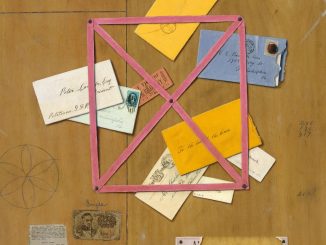
There’s a knotted pile of necklaces on top of your dresser. They’ve been entangled for as long as you can remember. Make some progress pulling one out—fit the loop past the beads, catch and uncatch against the clasps, tie a literal knot because nothing works, nothing works, nothing works—and finally, a moment of give. A moment of release, of pulling gently, carefully, breath held, only to have it catch again. In a new spot. Caught on a different necklace. One you hardly even remember getting (a string of pearls, probably from your grandmother.)
You have a date on Sunday. A friend from high school. Or, not a friend. You were on the school newspaper together. Though both of you knew, yourselves, you weren’t ready to be out (a black choker of woven plastic, still mixed in with the rest because you never get to stop coming out). So you two spent those years brushing elbows at the computer and hoping that everyone is a goddamned liar when they say high school is the pinnacle of human existence.
High school ended five years ago. You’ve been engaged and very, very not-engaged since then (a leather cord threaded through a bronze guitar pick) and she’s graduated and working in her field and doing everything everyone has told you isn’t possible anymore. You can only remember her frozen at fifteen even though you’ve thumbed through her profile pictures a dozen times trying to line that little girl up with the woman in a cap and gown, the woman cuddling with a tortoiseshell cat, the woman you’re meeting at a ‘90s themed party in an hour and you want that seashell necklace you got at the jersey shore with the boyfriend who raped you.
As your fingers touch the broken pieces of shells, you remember him so clearly. Torn cuticles, rum smelling morning breath, the way he always held you by the wrist instead of the hand. Your relationship with him fell right in line with who you were at the time, set you up so neatly for the coke and the bruises and the month you lived in your car (the sterling silver half of a friends forever set that ominously reads “forever.”) You think you’ve earned the right to get to wear the necklace he got you without feeling his breath hot against your throat and you don’t have time to be dealing with all this. You’re going to be late. You pull and double back; get some tweezers, a pair of scissors, pliers. It doesn’t budge. It bends and contorts and you keep trying.
For months you date this woman, touch this woman, love this woman. She even tries her hand at the detangling, but when she leaves you, you swear the necklaces you have—on display, on top of the dresser—are multiplying.
Focus. Give up dating for a year. Focus. You and your therapist tug at the necklaces (the gold-plated chain with a nickname you don’t go by anymore written in cursive—seven years recovering from an eating disorder in fits and bursts and relapses; a statement piece with violets and large plastic gemstones—realizing you were gay and saying it so freely at first that people thought they had to prove you wrong; a locket that won’t open but has a picture of your brother on his last birthday stuck inside—learning that there are certain days of the year when you need to just lie down and wait it out, face first on the carpet, if you must.) You yank and twist and fiddle in the vain hopes that one will dislodge so you can hold it. Analyze it. Allow it to exist on its own, without how it connects to every single moment after. You get some good work done. The pile has grown bigger: scarier, but looser.
You have a date on Tuesday. With a boy, or, he starts somewhere along that end of the spectrum, which you’re starting to think is more a circle than a line. Or free-floating dots scattered to their whims, like learning about uncorrelated data in your freshman stats class, which you don’t get a chance to take until you’re twenty-five because you can’t bear to be on a college campus after what happened when you were eighteen (your birthstones neatly encased in gold, the three men who never learned to keep their hands to themselves.)
This boy is sweet, and soft. You’ve been with boys before. In some performative, adolescent attempt at normalcy. In the hopes that gaining the love and trust of a man meant that they could no longer hurt you. As a form of self-harm. You try to tackle the violet necklace in the early days of your relationship with him, hoping its size and brightness will make it the easiest to fix. But every time he asks you if you want to have sex, you notice it has twisted with four others, seemingly on its own. When you leave him, you try to gift him the necklaces, but he won’t hold them. Can barely stand to look at them.
You have a date on Friday. You go over to the dresser and stare at the pile. You need to try, however desperately, however uselessly, to free just one fucking necklace, because you’ve never been any good at pretending to be the kind of person who doesn’t have necklaces. Your eyes find the layered gold chains, the rosary, the plastic beads, your mother’s claddagh ring on a piece of twine you can’t cut.
You breathe. Yes, you have the necklaces. Push the tangled mess off the dresser and into your palm. So many, many necklaces. Take in the weight of it. But, you also have the dresser. Put it in a box. And the box. Put the box on a shelf. And the shelf.
Breathe. You have a date tonight.
MAY BENNET is a preschool teacher who writes hopeful narratives about queer women. She’s been published in NYMBM, Out/Cast Magazine, and on her mother’s refrigerator.
Featured image: Photograph by Artem Beliaikin from Pexels.


